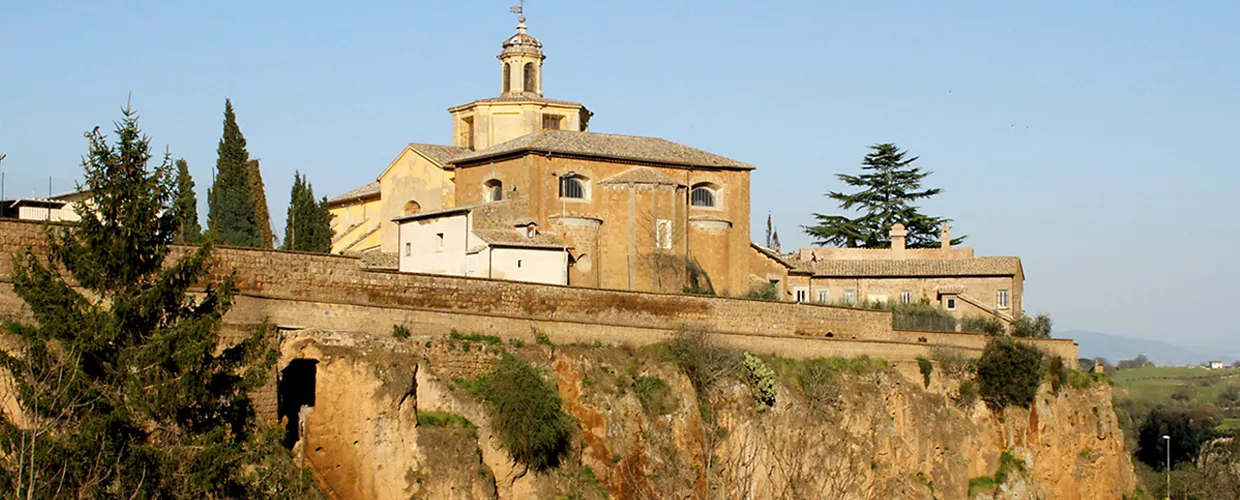This content was automatically translated. View the original text.

Overview
5 good reasons to fall in love with Civita Castellana
...with Goethe and Mozart and the ancient Falisci people
Halfway between Viterbo and Rome, Civita Castellana and its landscape enchanted even Goethe, who, on his way to the Eternal City, stopped in the village in 1786: "Beautiful is the view of the castle: Mount Soratte [...] stands solitary and picturesque. The volcanic areas are much lower than the Apennines, and only the watercourses, flowing impetuously, have incised them, creating hills and cliffs in stupendously plastic forms, precipitous rocks and a landscape that is all discontinuities and fractures."
Since then, nothing (or nearly nothing) has changed. May the journey start!
A long bridge over the gorge
The force of water forged the local landscape. Let’s imagine Goethe crossing the gorge on the long Ponte Clementino and stopping in the middle to look out and gaze, with a sense of vertigo, toward the Rio Maggiore, which, dozens of metres below, has carved out the tender tuffaceous rock in its rush toward the Treja river.
Through the streets of the village
The Cathedral of Santa Maria Maggiore, the religious heart of the town, appears to us from afar, as it appeared to Goethe and the Grand Tour travellers, resting on a steep tuffaceous wall. It is a masterpiece of the 13th century, with its facade embellished by a marvellous white portico and its magnificent marble floors in the interior. Did you know that even Mozart has played the organ in this church? It was a Sunday in July 1770, but it was so cold at night that he had to put on his fur coat! From the cathedral, we make our way through the narrow, charming streets to reach Piazza Matteotti, which, as in all villages in Italy, is the centre of the town's social life. Let's have a coffee in front of the 16th-century Fountain of Dragons and the elegant town hall.
Living like a local
The entire community of Civita participates with great passion in the feast of its patron saints, Saints Marciano and Giovanni, celebrated from the very first light of dawn on the 16th of September. The relics of the saints are kept in the Cathedral and are carried in solemn procession on the evening of the 16th. The traditional dish - not to be missed! - are the "frittelloni", a carnival classic: they are somewhat similar to crêpes, but thinner, seasoned with pecorino cheese and pepper and rolled tightly. The ingredients are poor - flour, water and eggs - but the taste is unforgettable. The local art that has been passed down for centuries is that of artistic ceramics: be sure to visit the many artisan workshops and meet the master potters.
Forte Sangallo
Massive and soaring, the fort is "the castle" that caught Goethe's eye, as much as ours. It is named after its architect, Antonio Sangallo the Elder, who designed it in the late 15th century to defend the northern borders of the Papal State. It has also served as a prison and as a papal residence and is now home to an Archaeological Museum, which opens a glimmer of light on the local most ancient history. Civita Castellana, in fact, in the distant past was called "Falerii" and was the capital of the lands of the Falisci, the ancient people of Lazio, wiped out by the Roman conquest in 241 BC.
Falerii Novi
What became of the Falisci people after 241 B.C.? To find out, we strap on our bikes and ride from Civita Castellana to the archaeological area of Falerii Novi, about 6 km away. "Novi" because it was built after 241 B.C., when Falerii Veteras was destroyed by the Romans. And here, in Falerii Novi, the wonder begins again: mighty defensive walls, two large gates (of Jupiter and of Bove), and within, among the vegetation, layers of history unravel from the Roman Empire to the barbarian invasions, when the inhabitants of Falerii Novi abandoned the city and returned to the old town. We will be able to walk with the ancient Romans along the Via Amerina that used to lead to Umbria; we will recognize the original urban layout recovered from the archaeological excavations; and we will be amazed in front of the Romanesque church of Santa Maria di Falerii (12th century).
Credit to: Croberto68
01033 Civita Castellana VT, Italia